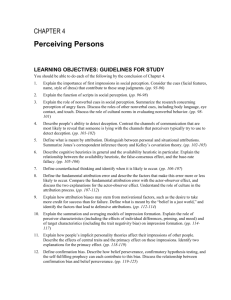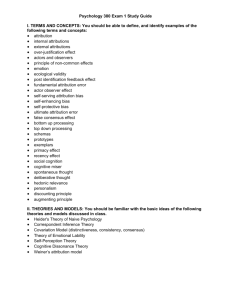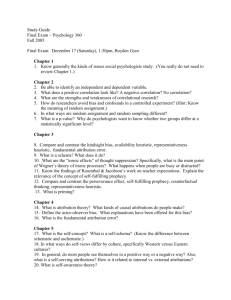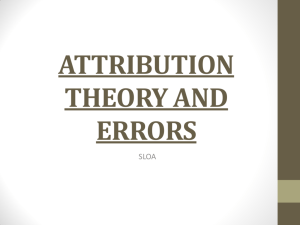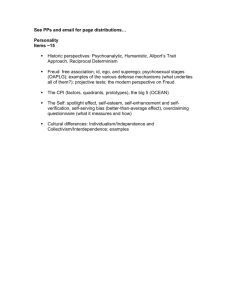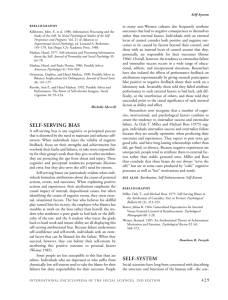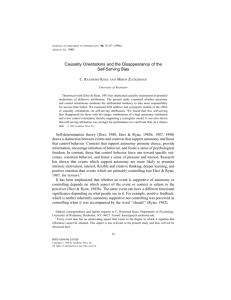Self-serving biases of students and teachers
advertisement
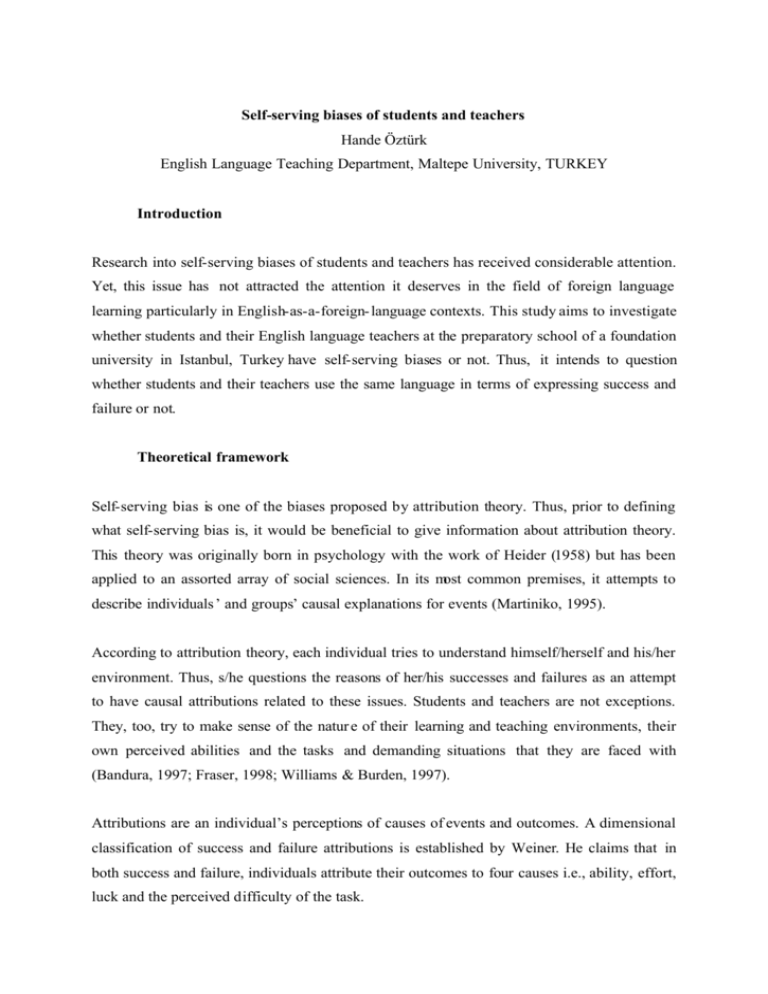
Self-serving biases of students and teachers Hande Öztürk English Language Teaching Department, Maltepe University, TURKEY Introduction Research into self-serving biases of students and teachers has received considerable attention. Yet, this issue has not attracted the attention it deserves in the field of foreign language learning particularly in English-as-a-foreign- language contexts. This study aims to investigate whether students and their English language teachers at the preparatory school of a foundation university in Istanbul, Turkey have self-serving biases or not. Thus, it intends to question whether students and their teachers use the same language in terms of expressing success and failure or not. Theoretical framework Self-serving bias is one of the biases proposed by attribution theory. Thus, prior to defining what self-serving bias is, it would be beneficial to give information about attribution theory. This theory was originally born in psychology with the work of Heider (1958) but has been applied to an assorted array of social sciences. In its most common premises, it attempts to describe individuals ’ and groups’ causal explanations for events (Martiniko, 1995). According to attribution theory, each individual tries to understand himself/herself and his/her environment. Thus, s/he questions the reasons of her/his successes and failures as an attempt to have causal attributions related to these issues. Students and teachers are not exceptions. They, too, try to make sense of the natur e of their learning and teaching environments, their own perceived abilities and the tasks and demanding situations that they are faced with (Bandura, 1997; Fraser, 1998; Williams & Burden, 1997). Attributions are an individual’s perceptions of causes of events and outcomes. A dimensional classification of success and failure attributions is established by Weiner. He claims that in both success and failure, individuals attribute their outcomes to four causes i.e., ability, effort, luck and the perceived difficulty of the task. The essential development of attribution theory has been the exploration of attributional dimensions (Russell, McAuley & Tarico, 1987; Weiner, 1986). These dimensions are of high importance in terms of comprehending self-serving bias. It is suggested that each attribution has three properties. These are stability, controllability and locus of control. Stability questions the potential changeability of a cause over time. The further dimension, controllability represents the extent to which an event or outcome is under the control of the learner (Williams & Burden, 1999). Locus of control is the attributional dimension which is directly related to self- serving bias. It refers to how an individual perceives the causes of events. In terms of causality, Weiner classifies loci of control into two groups i.e., internal and external. This classification is based on the assumption that individuals tend to perceive the causes due to internal factors or external factors. Internal attributions are personal. The individual attributes the cause for his/her behavior to something internal to himself/herself such as ability, effort etc. External attributions are situational. The individual attributes the cause for his/her behavior to something external such as luck, the perceived difficulty of the task etc. Someone with internal locus of control would generally perceive himself/herself as responsible for his/her actions and their results. On the contrary, someone with external locus of control would be more likely to blame and in good results thank fate, luck, the task or some other source beyond his/her control. This line of argument is essential in comprehending selfserving bias. Self-serving bias can be defined as having a tendency to take credits for successes and deny the responsibility for failures. It is like seeing oneself in a better light. Self-serving bias involves two biases i.e. self-enhancing bias and self-protecting bias. The former refers to taking credit for the self and the latter refers to denying responsibility for failure. Within an attribution theory framework, it is having internal attributions for success and external attributions for failures (Bradley, 1978; Miller, 1975; Zuckerman, 1978). Self-serving bias in educational settings can be defined as the tendency for students and teachers to ascribe causes of success to internal factors and failure to external factors. 2 Method Participants The participants in this study consisted of two groups: 150 preparatory level students studying English at a foundation university in Istanbul, Turkey and their 30 English teachers. All the participants of the student group were native speakers of Turkish. Because they could not score higher than 213 on the TOEFL exam or pass the proficiency exam prepared by the testing office of the university, they had to take preparatory courses for a year in order to begin their undergraduate programme. The participants of the teacher group were non-native English teachers with different years of experience ranging from one year to forty- four years. They were graduates of various universities from different departments such as English Language Teaching, English Language, Literature and Linguistics. Instruments and data analysis For the purposes of the study, data were obtained through the use of three different instruments.Both of the groups were given an Attribution Questionnaire developed for the present study and the Revised Causal Dimension Scale (McAuley, Duncan & Russell, 1992). The teacher group was also given Teacher Locus of Control Scale (Rose & Medway, 1982). The analysis of the findings was done by means of comparing and contrasting the answers given to the questions by two groups. The ratio and percentage calculations were done and the total number was computed through group scoring. Results A number of analyses were performed to compare students’ and teachers’ perceptions of successes and failures in English language learning. Attributing successful or unsuccessful outcomes internally or externally was investigated. No gender or age differences were taken into consideration. The results were analyzed only on the basis of being a student or an English teacher. 3 Results of the Attribution Questionnaire The results of the Attribution Questionnaire indicated that there is a difference between the two groups in terms of attributing successes and failures in English language learning. 59% of the teacher group attributed success and failure externally. 41% of the group attributed success and failure internally. Compared to the responses of the teacher group, a significant shift of the internal-external aspect was found in the student group. It was found that 77% of the student group provided internal causes whereas only 23% of the same group provided external causes. Results of the Revised Causal Dimension Scale The results of the Causal Dimension Scale displayed similarities between student group and teacher group. The results indicated that both of the groups had internal causal attribution. Before mentioning the percentages, it is of vital importance to note here that some of the responses were accepted as neutral and not calculated in the percentage of internal or external causality. The results indicated that 60% of the student group showed internal causality and 24% of the same group showed external causality. Data gathered from the teacher group revealed that 56% of the group attributed causality internally and 22% of the same group attributed causality externally. Results of the Teacher Locus of Control The results of the Teacher Locus of Control Scale revealed that 52.1% of the group favored external and 47.9% of the same group favored internal causality in terms of success. In terms of failure, 70.6% of the teacher group showed external causality and only 29.4% of the same group showed internal causality. When the results of the three instruments are taken into consideration it can be concluded that a majority of the student group attributed both success and failure conditions internally. On the other hand, the causality attributions of the majority of the teacher group were somewhat contradictory. With the instrument that investigated causal attribution in everyday life 4 situations, the teacher group favored internal causality. Strikingly, with the instrument that investigated causal attributions related to educational settings, the teacher group favored external causality. Thus, as individuals participating teachers had internal causality in life. When it comes to the educational sphere, they showed external causality. Discussion The participating students showed an internal attribution in both success and failure outcomes. It may be argued that students take full responsibility in both success and failure outcomes. In the literature, it has been mentioned that when there is probability of improvement, people attribute failure outcomes internally. In hopeless situations, they tend to attribute failure externally. The internally attributed causality may be explained with a reference to individuals’ need to look good. Participating students may have desired to preserve their image. This is in line with the literature (Schunk, 1990). It may also be argued that teachers may have influenced the causal attributions of their students. The students may have inferred that since teachers were always expected to be successful then it must have been the underachiever to who m the problem was related. Teachers may have influenced students with suggestions about studying hard, having high aptitude and attending the class hours regularly. In such suggestions, the implied message is that success depends on the learner. The participating teachers tended to attribute success and failure situations externally without viewing themselves as responsible. It may be argued that once they consider success and failure results irrespective of themselves, they have no responsibility in the failure situations. This releases the tension of being an unsuccessful or insufficient teacher. The burden of being unsuccessful is supposed to be shouldered by the students. It would not be wrong to note here that external attribution was found in case of successes. Thus, in line with the self-serving bias, the teachers tended to leave the failures to their students but unlike the hypothesis they did not take credits for successes. They tend to depersonalize themselves from both of the outcomes and relate the outcomes- positive or negative- directly to their students. 5 Conclusion Studies like the present one show a growing interest in the label of self-serving bias. Selfserving biases are learned and thus there is possibility of change due to awareness raising. The findings of this study showed how important it is to have teacher training programmes that include detailed lecturing about self-serving bias. The findings of this study should be viewed in the light of its limitatio ns. As in the case of most comparative studies in the field, it was difficult to draw strong generalizations due to the limited number of participants. Further research with a greater number of students and teachers may yield further information about self-serving mechanisms. 6 References Bandura, A. (1997). Self-efficacy: The exercise of control. New York: W. H. Freeman. Bradley, G. W. (1978). Self-serving biases in the attribution process: A re-examination of the fact or fiction question. Journal of Personality and Social Psychology, 36, 56-71. Fraser, B. J. (1998). Classroom environment instruments: Development, validity and applications. Learning Environments Research, (1), 7-33. (Kluwer Academic Publishers). Heider, F. (1958). The psychology of interpersonal relations. New York: Wiley. Martiniko, M. J. (1995). The Blackwell dictionary of organizational behavior. N. Nicholson (Ed.). London: Blackwell Publishers. McAuley, E., Duncan, T. E., & Russell, D. W. (1992). Measuring causal attributions: The revised causal dimension scale. Personality and Social Psychology Bulletin, 18, (5), 566-573. Miller, D. T. (1975). Self-serving biases in the attribution of causality: Fact or fiction? Psychological Bulletin, 82, 213-225. Rose, J. S., & Medway, F. J. (1982). Measurement of teachers’ beliefs in their control over student outcome. Journal of Educational Research, 74, 185-189. Russell, D. W., McAuley, E., & Tarico, V. (1987). Measuring causal attributions for success and failure: A comparison of methodologies for assessing causal dimensions. Journal of Personality and Social Sciences, 52 (6), 1248-1257. Schunk, D. H. (1990). Introduction to the section on motivation and efficacy. Journal of Educational Psychology, 82 (1), 3-6. Weiner, B. (1986). An attributional theory of motivation and emotion. New York: SpringerVerlag. Williams, M., & Burden, R. L. (1997). Psychology for teachers. Cambridge: Cambridge University Press. Williams, M., & Burden, R. L. (1999). Students’ developing conceptions of themselves as language learners. The Modern Language Journal, 83 (2), 193-201. Zuckerman, M. (1978). Attribution of success and failure revisited, or the motivational bias is alive and well in attribution theory. Journal of Personality, 47, 245-287. 7

